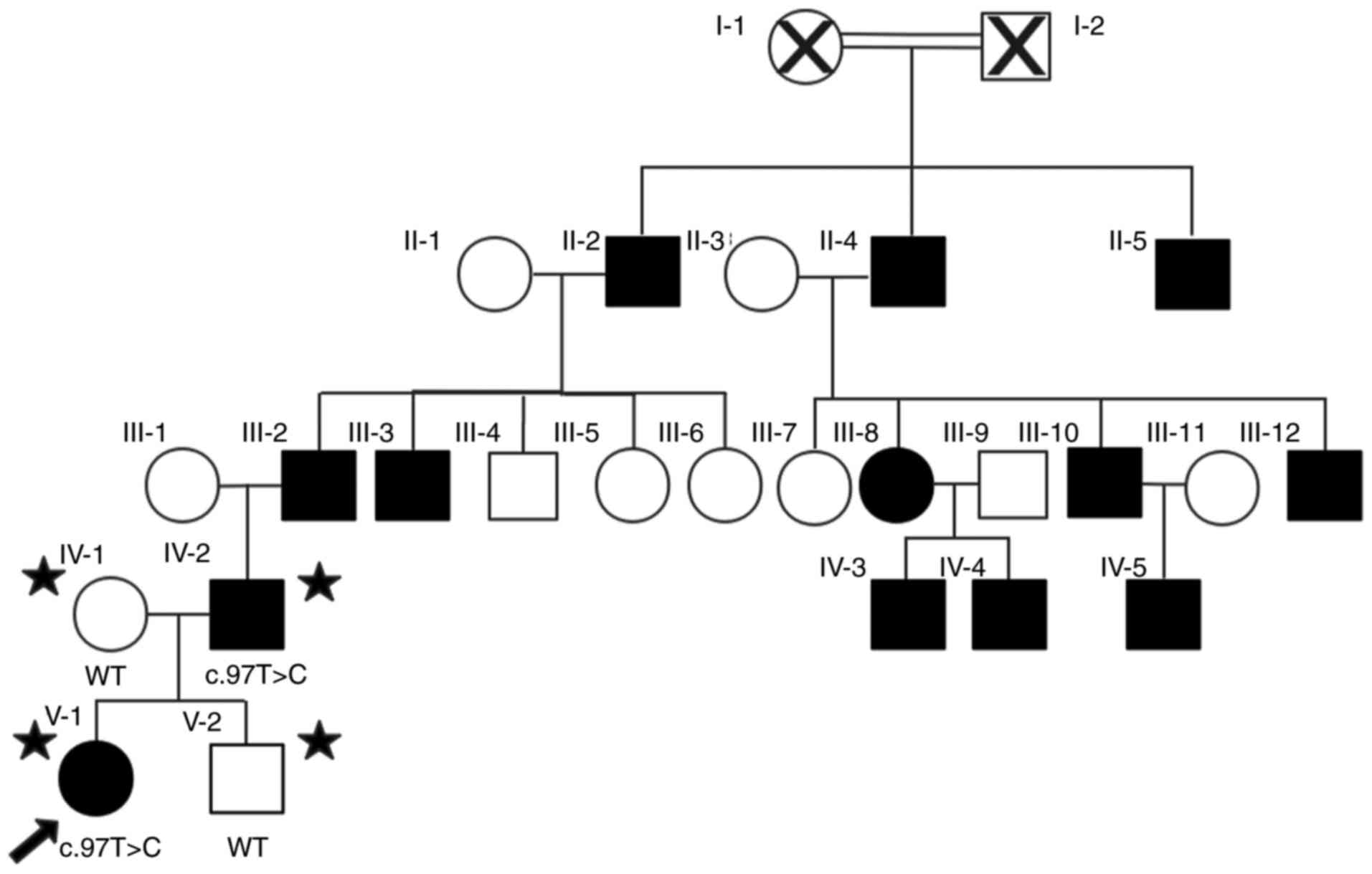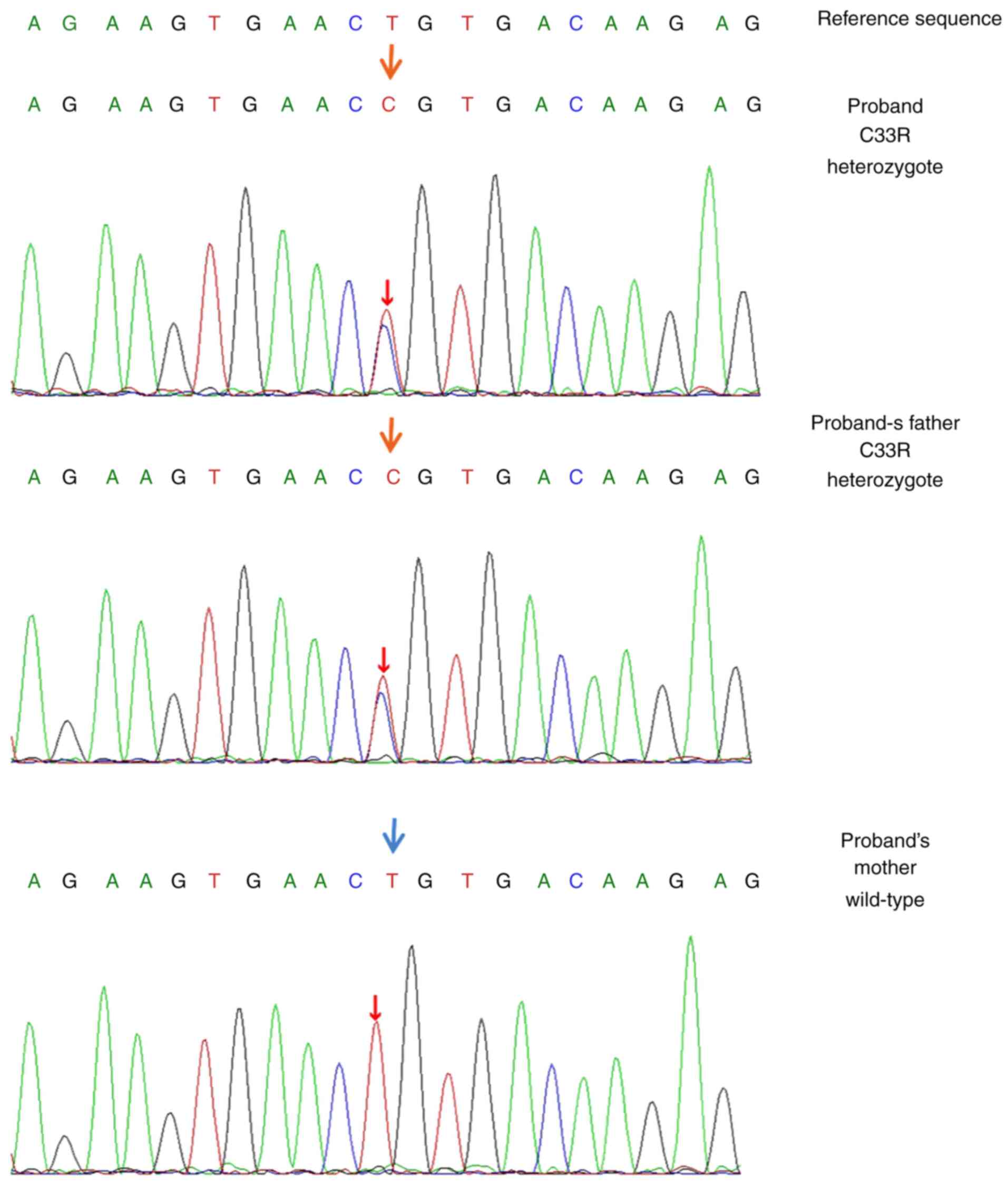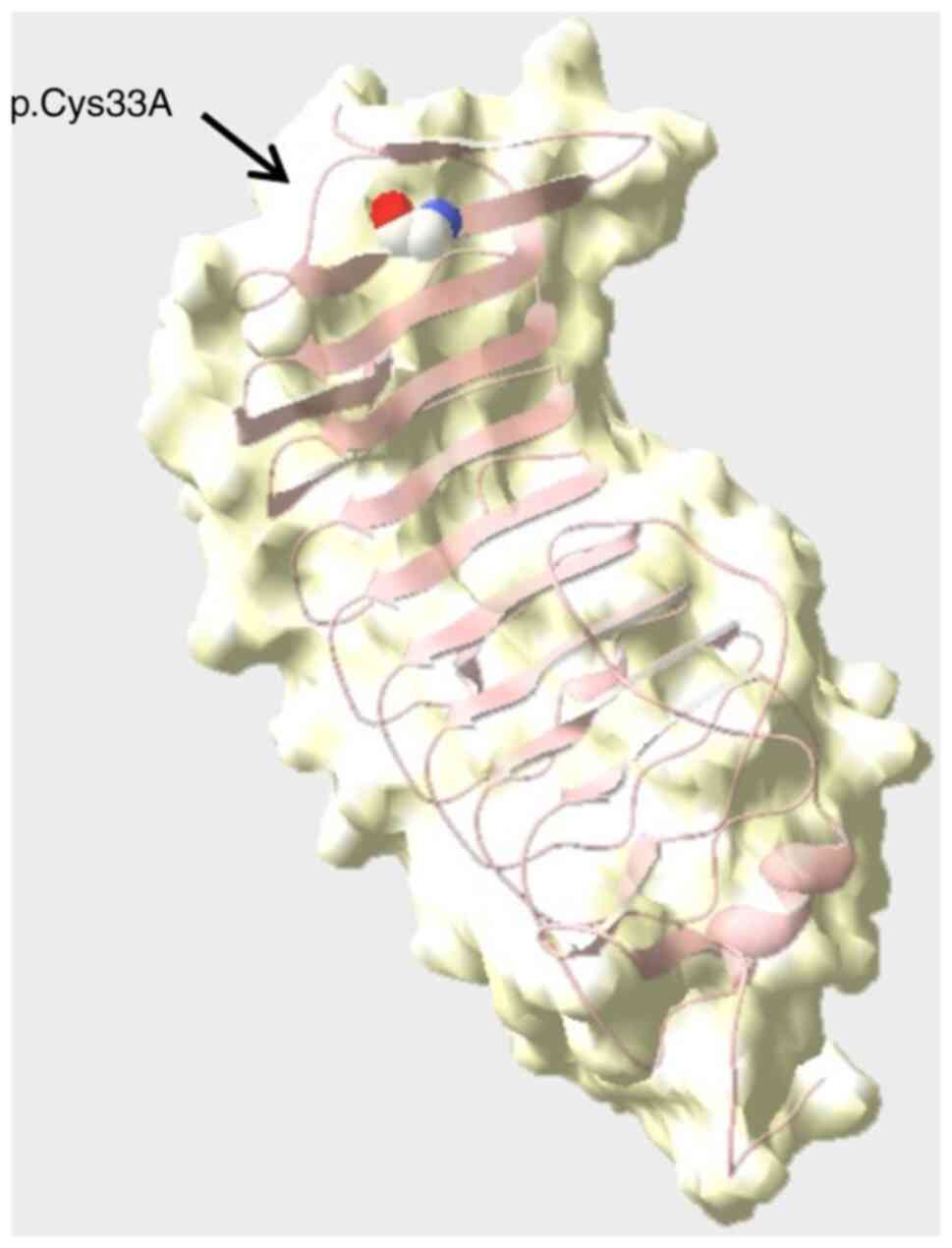A novel mutation in GP1BA gene in a family with autosomal dominant Bernard Soulier syndrome variant: A case report
- Authors:
- Published online on: February 13, 2021 https://doi.org/10.3892/etm.2021.9791
- Article Number: 360
-
Copyright: © Ma et al. This is an open access article distributed under the terms of Creative Commons Attribution License.
Abstract
Introduction
The Bernard-Soulier syndrome (BSS) is an extremely rare congenital disease that is characterized by macrothrombocytopenia and defective binding of platelets to the von Willebrand factor (vWF), which participates in the adherence of platelets to the vascular subendothelial layer (1). BSS disease pathogenesis lies in the expression of vWF receptor via the glycoprotein Ib-IX-V (GPIb-IX-V) complex (2). The GPIb-IX-V complex consists of four subunits, glycoprotein (GP)Ibα, GPIbβ, GPIX and GPV, which are encoded by glycoprotein Ib platelet subunit alpha (GP1BA), glycoprotein Ib platelet subunit beta (GP1BB), GP9 and GP5(3). Mutations that occur in GP1BA, GP1BB and GP9 may lead to BSS (4). The major subunit, GPIbα, holds an essential ligand-binding site for vWF within its N-terminal domain, and this features the leucine-rich repeat (LRR) (5,6). Pathogenic mutations in its GP1BA gene are classically inherited as a biallelic, autosomal recessive trait (4). A milder phenotype caused by monoallelic autosomal dominant inheritance that shares characters with BSS, including macrothrombocytopenia, has been previously reported (6-12). However, this aforementioned phenotype does not lead to severe bleeding or serious surgical or obstetric hemorrhage that is commonly seen in BSS. Therefore, the autosomal dominant variant of BSS can be easily misdiagnosed as immune thrombocytopenia (ITP) and managed with intravenous immunoglobulin and glucocorticoids, which are used as a first-line treatment for ITP (13,14).
In the present case report, sequence analysis performed on an 18-month-old girl identified an NM_000173 c.97T>A (p.Cys33Arg) (p.C33R) heterozygous missense mutation in GP1BA. This specific mutation has not been previously reported and may further expand the information regarding mutations in BSS.
Case report
An 18-month-old girl with thrombocytopenia consulted the Hematology Oncology Center, Beijing Children's Hospital, Capital Medical University (Beijing, China). A period of six months prior to admission to the department, the patient underwent a physical examination, which revealed a baseline platelet count of 31x109/l. Since this examination, the patient had no bleeding symptoms, including easy bruising, epistaxis, gingival bleeding and other symptoms as a result of internal bleeding. A peripheral blood smear indicated giant platelets and a reduction in platelet count. vWF antigen (vWF Ag) levels was 94.6% (42.0-140.8%), aggregation response of platelets after adenosine diphosphate (ADP) was 55% (55-90%), collagen was 62.1% (55-90%), arachidonic acid was 82.6% (55-90%) and ristocetin was including low concentration and [76.1% (55-90%); low concentation] and [2.6% (<3%); standard concentration], all of which were within the normal range. CBC, peripheral blood smear and platelet aggregation were performed on the patients parents, and the patients father shared a similar phenotype, including enlarged platelet size and normal aggregation rate of platelet as follows: Aggregation response of platelets after adenosine diphosphate (ADP) was 56.4% (55-90%), collagen was 72.3% (55-90%), arachidonic acid was 85.7% (55-90%) and ristocetin, including low concentration and standard concentration, was 66.7% (55-90%) and 1.3% (<3%) respectively. Considering the probability of inherited thrombocytopenia and abnormal morphology of platelets, DNA samples for genetic analysis were collected from her parents. Written consent from the patient's parents was obtained at the time of sample collection. The present study was performed with approval from the Ethics Committee of Beijing Children's Hospital (Beijing, China; reference no. 2020-Z-113).
Approximately 2 ml peripheral blood of the patient, parents and one sibling were collected in new EDTA containing tubes (as anticoagulant) for genetic analysis. Exome sequencing of germline DNA samples was performed using a QIAamp DNA Mini kit (Qiagen, China Co., Ltd.), according to the manufacturer's protocol. Selected targeted genes that were associated with thrombocytopenia were analyzed using a gene capture strategy with a GenCap custom enrichment kit (MyGenostics, Inc.), following the manufacturer's protocol. The final enriched sequencing libraries were sequenced for paired-end reads of 150 bp using Illumina NovaSeq 6000 platform (Illumina, Inc.). The identified variants were annotated using ANNOtate VARiation (ANNOVAR; http://annovar.openbioinformatics.org/en/latest/).
The sequencing analysis identified a heterozygous nucleotide substitution in the GP1BA gene (NM_000173: exon2:c.97T>G). An amino acid of cysteine 33 was substituted with arginine in the N-terminal domain of GPIbα protein on the platelet membrane. A validation of GP1BA sequencing was performed on the patient's parents and one sibling. The pedigree analysis (Fig. 1) indicated an autosomal-dominant mode of inheritance. The individuals father carried a similar heterozygous p.C33R variant, while her mother carried a wild-type sequence (Fig. 2). The structural effect of the sequence variant was predicted to be deleterious via in-silico analysis (Fig. 3), using the following software with default parameters: Mutation Taster (http://www.mutationtaster.org/), Sorting Intolerant From Tolerant (http://sift.jcvi.org/), PolyPhen-2 (http://genetics.bwh.harvard.edu/pph2/) and Genomic Evolutionary Rate Profiling (http://mendel.stanford.edu/SidowLab/downloads/gerp/index.html). According to the ACMG guidelines (15), the variant was classified as ‘likely pathogenic’, which confirmed BSS.
Discussion
In the current case report, a novel heterozygous c.97T>A substitution was reported in the GP1BA gene, which causes a Cys33Arg amino acid substitution. The mutation was annotated with ANNOVAR and the results demonstrated that it has not been recorded in the GnomAD (https://gnomad.broadinstitute.org/), 1000 Genomes (http://www.1000genomes.org/), ExAC database (16), the human gene mutation database (http://www.biobase-international.com/product/hgmd; http://www.hgmd.cf.ac.uk/ac), OMIM (https://www.omim.org/) or ClinVar databases (https://www.ncbi.nlm.nih.gov/clinvar/). To date, ~60 variants of GP1BA encoding GPIBα protein have been identified, and the majority of these are homozygous and contribute to symptoms of BSS (6,17). However, the symptoms of individuals in the pedigree of the current study seemed milder than the symptoms of individuals with classic homozygous BSS. Platelet aggregation of the present patients with heterozygous BSS (including the response to the low concentration of ristocetin) appeared normal despite giant platelets being identified in the results of the peripheral blood smear.
Mutations in BSS may be missense, nonsense, frameshift, insertions or deletions, and these mutations can cause abnormality in GPIBα protein expression (18,19). The dominant inheritance of BSS remains relatively rare as only six variants have been previously identified, including the Bolzano variant (p. Ala172Val), which is the most frequent type in Italy (12). The remaining four heterozygous mutations were described in single families (6-12).
The phenotype of monoallelic BSS, which is the same as that of the biallelic BSS in the degree of symptom presentation, may vary based on different genotypes and relevant changes in the expression and function of GPIbα (2). Mutations in the patient outlined in the current case report and her father were located in the conserved N-terminal flanking domain. The domain lies ahead of the LRR region of GP Ibα, which serves a role in the orientation of charged residues (6). All previously reported variants (p.Ala172Val, p.Asn57His, p.Tyr70Asp, p.Leu73Phe, p.Asn150Ser and p.Leu59Arg), which are located in the LRR region (amino acids 35-200), may lead to macrothrombocytopenia. This is due to the abnormal interaction of the cytoplasmic end of GPIbα protein with the actin-binding protein, which controls the normal process of megakaryocyte maturation, demarcation membrane system production and the size of the platelets (20,21). While the conserved N-terminal flanking region of GPIbα, where the novel mutation was discovered in the pedigree outlined the present study, may interact with C-terminal flanking (amino acid 201-268) and exhibit a weak influence on the binding of GPIbα to vWF that is induced by ristocetin or botrocetin, the mutations within the LRR caused a more significant change in the formation of GPIbα as well as a pronounced disturbance in ligand binding (22).
BSS is commonly misdiagnosed with ITP and is subsequently treated with futile therapies, including glucocorticoids and immunoglobulins (14). BSS is a rare bleeding disorder that is accompanied by thrombocytopenia, and symptoms are less pronounced in the monoallelic phenotype of the disease (6,8). BSS shares similar clinical characteristics with ITP, such as mucocutaneous bleeding, negative family history and normal platelet aggregation (14). However, the identification of giant platelets in a peripheral blood smear may help clinicians make an accurate diagnosis. In the current case report, the patient and her father shared the same mutation and similar mild manifestation. Her mother carried a wild-type genotype and did not exhibit macrothrombocytopenia and bleeding. For those suspected of having BSS, gene sequencing should be performed, and symptoms such as abnormal levels of bleeding should be investigated throughout the family to encourage early diagnosis and subsequently, the establishment of effective treatment.
In the present study, platelet immunophenotype and vWF-cofactor activity analysis (binding of VWF to recombinant mutated GPIb) could not be performed. Therefore, whether this novel dominant variant contributes to the reduced expression of GPIb-V-IX and whether the inactive interaction between platelets and vWF was indicated, which is commonly identified in classic BSS, was not confirmed. Identification of the effect of specific mutations on the structure and function of GPIbα protein and the pathogenesis to a milder phenotype is required in future studies.
A novel autosomal dominant inheritance mutation in GP1BA was identified in a family with mild bleeding symptoms and macrothrombocytopenia. This monoallelic mutation that occurs in the N-terminal flanking domain has, to the best of our knowledge, not been previously reported. Due to common misdiagnosis, gene sequencing is considered essential and urgent for diagnosing suspected patients who exhibit a blood smear showing giant platelets, with BSS.
Acknowledgements
The authors would like to thank Dr Lulu Mao and Mr. Xinwen Fu from MyGenostics, Inc. for technical support in NGS work and drawing the crystal structure.
Funding
Funding: The present study was supported by the National Natural Science Foundation of China (grant no. 81970111), the Beijing Natural Science Foundation of China (grant no. 7192064), the Pediatric Medical Coordinated Development Center of Beijing Municipal Administration of Hospitals (grant no. XTZD20180205) and the National Science and Technology Key Projects (grant no. 2017ZX09304029004).
Availability of data and material
The datasets used and/or analyzed during the current study are available from the corresponding author on reasonable request.
Authors' contributions
JM was involved in the collection and critical analysis of clinical data and wrote the manuscript. RW contributed to the designing the study, supervision and critical review of the manuscript. ZC contributed to the supervision and critical analysis of laboratory data, including the interpretation of NGS results. GL performed the platelet aggregation. HG was involved in the collection and sorting of the clinical data. RW and ZC confirmed the authenticity of all the raw data. All authors read and approved the final manuscript.
Ethics approval and consent to participate
The present study was approved by the Ethics Committee of Beijing Children's Hospital (Beijing, China; reference no. 2020-Z-113) and written consent from the patient's parents was obtained.
Patient consent for publication
The patient's parents have provided consent for publication.
Competing interests
The authors declare that they have no competing interests.
References
|
López JA, Andrews RK, Afshar-Kharghan V and Berndt MC: Bernard-Soulier syndrome. Blood. 91:4397–4418. 1998.PubMed/NCBI | |
|
Savoia A, Pastore A, De Rocco D, Civaschi E, Di Stazio M, Bottega R, Melazzini F, Bozzi V, Pecci A, Magrin S, et al: Clinical and genetic aspects of Bernard-Soulier syndrome: Searching for genotype/phenotype correlations. Haematologica. 96:417–423. 2011.PubMed/NCBI View Article : Google Scholar | |
|
Andrews RK, Gardiner EE, Shen Y, Whisstock JC and Berndt MC: Glycoprotein Ib-IX-V. Int J Biochem Cell Biol. 35:1170–1174. 2003.PubMed/NCBI View Article : Google Scholar | |
|
Savoia A, Kunishima S, De Rocco D, Zieger B, Rand ML, Pujol-Moix N, Caliskan U, Tokgoz H, Pecci A, Noris P, et al: Spectrum of the mutations in Bernard-Soulier syndrome. Hum Mutat. 35:1033–1045. 2014.PubMed/NCBI View Article : Google Scholar | |
|
Othman M and Emsley J: Gene of the issue: GP1BA gene mutations associated with bleeding. Platelets. 28:832–836. 2017.PubMed/NCBI View Article : Google Scholar | |
|
Trizuljak J, Kozubík KS, Radová L, Pešová M, Pál K, Réblová K, Stehlíková O, Smejkal P, Zavřelová J, Pacejka M, et al: A novel germline mutation in GP1BA gene N-terminal domain in monoallelic Bernard-Soulier syndrome. Platelets. 29:827–833. 2018.PubMed/NCBI View Article : Google Scholar | |
|
Ghalloussi D, Saut N, Bernot D, Pillois X, Rameau P, Sébahoun G, Alessi MC, Raslova H and Baccini V: A new heterozygous mutation in GP1BA gene responsible for macrothrombocytopenia. Br J Haematol. 183:503–506. 2018.PubMed/NCBI View Article : Google Scholar | |
|
Noris P, Perrotta S, Bottega R, Pecci A, Melazzini F, Civaschi E, Russo S, Magrin S, Loffredo G, Di Salvo V, et al: Clinical and laboratory features of 103 patients from 42 Italian families with inherited thrombocytopenia derived from the monoallelic Ala156Val mutation of GPIbα (Bolzano mutation). Haematologica. 97:82–88. 2012.PubMed/NCBI View Article : Google Scholar | |
|
Vettore S, Scandellari R, Moro S, Lombardi AM, Scapin M, Randi ML and Fabris F: Novel point mutation in a leucine-rich repeat of the GP1Balpha chain of the platelet von Willebrand factor receptor, GPIb/IX/V, resulting in an inherited dominant form of Bernard-Soulier syndrome affecting two unrelated families: The N41H variant. Haematologica. 93:1743–1747. 2008.PubMed/NCBI View Article : Google Scholar | |
|
Kunishima S, Imai T, Hamaguchi M and Saito H: Novel heterozygous missense mutation in the second leucine rich repeat of GP1Balpha affects GPIb/IX/V expression and results in macrothrombocytopenia in a patient initially misdiagnosed with idiopathic thrombocytopenic purpura. Eur J Haematol. 76:348–355. 2006.PubMed/NCBI View Article : Google Scholar | |
|
Miller JL, Lyle VA and Cunningham D: Mutation of leucine-57 to phenylalanine in a platelet glycoprotein Ib alpha leucine tandem repeat occurring in patients with an autosomal dominant variant of Bernard-Soulier disease. Blood. 79:439–446. 1992.PubMed/NCBI | |
|
Savoia A, Balduini CL, Savino M, Noris P, Del Vecchio M, Perrotta S, Belletti S, Poggi and Iolascon A: Autosomal dominant macrothrombocytopenia in Italy is most frequently a type of heterozygous Bernard-Soulier syndrome. Blood. 97:1330–1335. 2001.PubMed/NCBI View Article : Google Scholar | |
|
Balduini CL, Savoia A and Seri M: Inherited thrombocytopenias frequently diagnosed in adults. J Thromb Haemost. 11:1006–1019. 2013.PubMed/NCBI View Article : Google Scholar | |
|
Reisi N: Bernard-Soulier syndrome or idiopathic thrombocytopenic purpura: A case series. Caspian J Intern Med. 11:105–109. 2020.PubMed/NCBI View Article : Google Scholar | |
|
Richards S, Aziz N, Bale S, Bick D, Das S, Gastier-Foster J, Grody WW, Hegde M, Lyon E, Spector E, et al: Standards and guidelines for the interpretation of sequence variants: A joint consensus recommendation of the American College of Medical Genetics and Genomics and the Association for Molecular Pathology. Genet Med. 17:405–424. 2015.PubMed/NCBI View Article : Google Scholar | |
|
Wang K, Li M and Hakonarson H: ANNOVAR: Functional annotation of genetic variants from high-throughput sequencing data. Nucleic Acids Res. 38(e164)2010.PubMed/NCBI View Article : Google Scholar | |
|
Proulle V, Strassel C, Perrault C, Baas MJ, Moog S, Mangin P, Nurden P, Nurden A, Adam F, Bryckaert M, et al: A novel missense mutation in a leucine-rich repeat of GPIbα in a Bernard-Soulier variant reduces shear-dependent adherence on von Willebrand factor. Br J Haematol. 186:e184–e187. 2019.PubMed/NCBI View Article : Google Scholar | |
|
Li R and Emsley J: The organizing principle of the platelet glycoprotein Ib-IX-V complex. J Thromb Haemost. 11:605–614. 2013.PubMed/NCBI View Article : Google Scholar | |
|
Simon D, Kunicki T and Nugent D: Platelet function defects. Haemophilia. 14:1240–1249. 2010. | |
|
López JA: The platelet glycoprotein Ib-IX complex. Blood Coagul Fibrinolysis. 5:97–119. 1994.PubMed/NCBI | |
|
Mhawech P and Saleem A: Inherited giant platelet disorders. Classification and literature review. Am J Clin Pathol. 113:176–190. 2000.PubMed/NCBI View Article : Google Scholar | |
|
Cauwenberghs N, Vanhoorelbeke K, Vauterin S and Deckmyn H: Structural determinants within platelet glycoprotein Ibalpha involved in its binding to von Willebrand factor. Platelets. 11:373–378. 2000.PubMed/NCBI View Article : Google Scholar |












